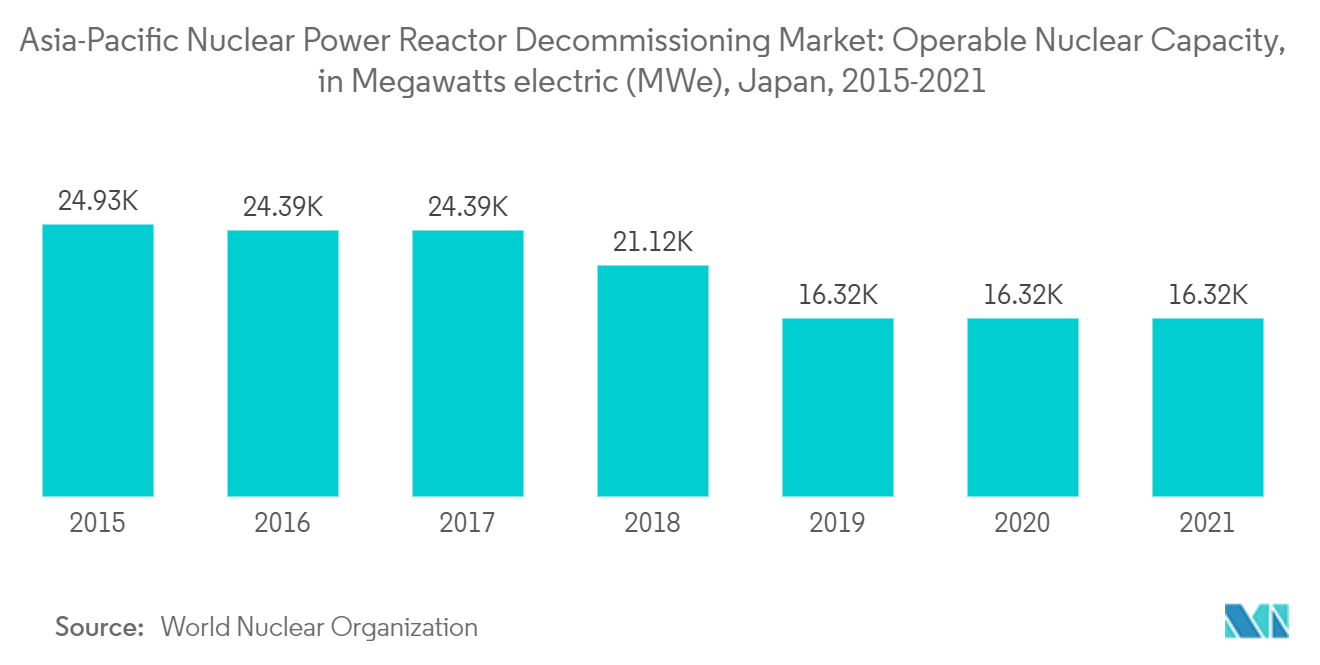Market Trends of Asia-Pacific Nuclear Power Reactor Decommissioning Industry
This section covers the major market trends shaping the APAC Nuclear Power Reactor Decommissioning Market according to our research experts:
Commercial Power Reactor Expected to Dominate the Market
- Commercial nuclear power plants are the power plants deployed in the region to generate electricity and utilized in the national energy grid through which the generated electricity is transmitted and distributed to various sectors of the country. In the Asia-pacific region, the majority of the nuclear power plants fall under the commercial reactor category.
- According to World Nuclear Association, 140 active commercial nuclear power plants exist in the Asia-pacific region. Moreover, 35 commercial power plants are in the construction stage, while around 40-50 commercial power plants are in the planning stages.
- The major countries in the region, such as China, Japan, South Korea, and India, are expected to drive the nuclear power reactor decommissioning market in the Asia-Pacific region during the forecast period, as the region has more than 70 reactors that are designed and built in the 1960s and 1970s.
- The total power produced by nuclear energy in Asia-Pacific in 2021 was 714.3 terawatt-hours (TWh), which was higher than the region produced in 2020, which was 655 TWh. Many countries in the region are still developing nuclear power for electricity, which is anticipated to hinder the regional market growth.
- In 2021, Korea Hydro & Nuclear Power (KHNP) applied to the Nuclear Safety & Security Commission (NSSC) for approval to dismantle unit 1 of the Kori nuclear power plant near Busan. The unit was permanently shut down in June 2017, becoming the first South Korean reactor to enter decommissioning. The company is waiting for the permit approval.
- Hence, owing to the above points, the commercial power reactor will likely dominate the Asia-Pacific nuclear power reactor decommissioning market during the forecast period.

Japan Expected to Dominate the Market
- As of 2021, Japan has generated 61.2 TWh of electricity from its thirty-three nuclear reactors with a combined capacity of 31.68 GWe. As of December 2022, the country has two nuclear reactors under construction with a combined total of 2.75 GWe; one reactor is under planning stages with a total of 1.38 GWe, and eight reactors with a combined capacity of 11.56 GWe under construction, planned, and proposed stages, respectively. The country's first commercial nuclear power reactor began operating in mid-year 1966, and nuclear energy has been a national strategic priority since 1973. This came under review after the 2011 Fukushima accident.
- As of 2021, Japan's operable nuclear energy capacity reduced to 16321 MWe compared to 24932 MWe in 2015. This decreasing capacity signifies Japan's effort to reduce its nuclear capacity.
- As of December 2022, Japan has shut down 27 nuclear reactors with a total capacity of 17128 MWe. But still, the country's 8% of electricity needs are met through nuclear energy.
- Moreover, in light of the war between Ukraine and Russia, the government of Japan shifted its focus to gaining energy security. Thus, the government announced that the country would accelerate the restart of nine units by winter 2022 and seven units by summer 2023.
- Furthermore, in November 2023, the Ministry of Economy, Trade, and Industry proposed an action plan to replace old nuclear power plants with modern, safer ones and create a path for some reactors to remain in operation for more than 60 years by excluding inspection delays. As per this action plan, most of the 33 operable nuclear power plants will be decommissioned in the coming years.
- For instance, in 2021, Japan's nuclear regulator approved Tokyo Electric Power Company's (Tepco's) decommissioning plan for the four reactors at its Fukushima Daini nuclear power plant, close to the damaged Fukushima Daiichi plant. The decommissioning process is expected to take 44 years. The 10,000 fuel assemblies held in the units' storage pools will be removed over 22 years and will be reprocessed.
- Hence, owing to the above points, Japan is expected to dominate the Asia-Pacific nuclear power reactor decommissioning market during the forecast period.


